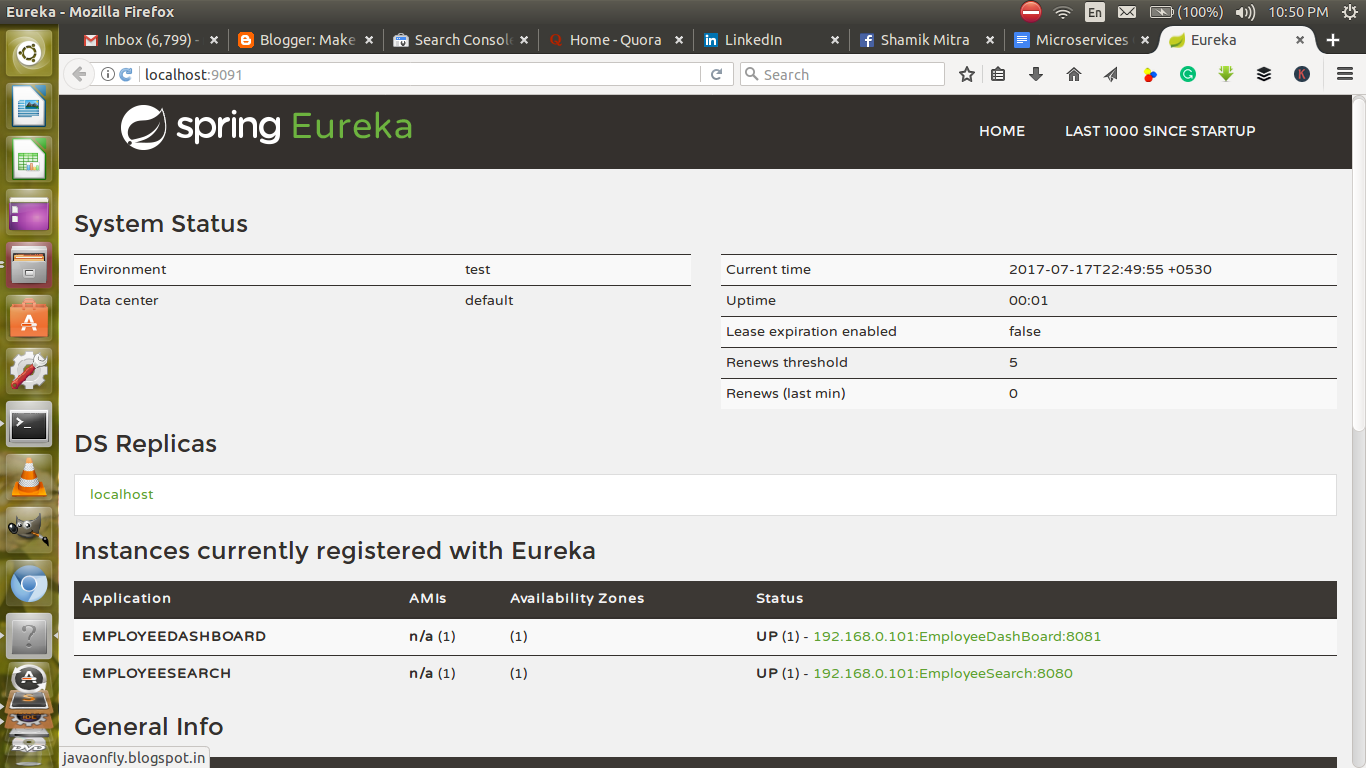Microservices Communication: Service to service
In the previous microservice tutorial, we have learned How Microservice communicates with the service registry. In this tutorial, we will learn How one microservice communicates with another dependent microservice service via the Service Registry/Eureka Server. This is the second part of Microservice Communication series.
Let see the sequence How One Microservice calls another Microservice using Eureka server.
Registering Service: All Microservices should be registered into Service registry with a Unique name {service-id}, So it can be identified please note that it is an important step as one of the main benefits of Microservice is autoscaling so we can’t rely on Hostname/Ip address so Unique name is important in distributed environment.
Fetching Registry: Before calling the downstream/dependent service Caller service fetch the registry from Eureka server, Registry contains all the active services register into service registry.
Find the Downstream service: Now using the unique service Id caller service get the instance of downstream service.
Resolve Underlying IP address : Please note the Iniques service id act as a Key in service registry but network does not know about it network expects Hostname to call the desired Rest Endpoint on the dependent service like(localhost:8080/employee/{id} or employee.cognizant,com/2 etc) so it is required to resolve the actual hostname of the dependent service Eureka API provides a method for that we just invoke that method to get the Ip address, For a distributed system it is the public IP of Load balancer.
Call the Rest Endpoint: After resolving the IP address using Spring Resttemplate we call the actual Rest endpoint and got the data.
Coding Time :
For this example we need Three Microservices Project
Employee Search Service : Which we created earlier for searching Employee information.
Eureka Server : Also ,we created this earlier we will reuse that same application
Employee Dashboard Service : We will create this module and call the Employee Search service via Eureka server to get Employee information.
Step 1:Create a service called EmployeeSearchSearch.java where I insert some employee using static block and using Java 8 Stream after that I add two methods findById and findAll to display Employee information accordingly.
package com.example.EmployeeSearchService.service;
import java.util.Collection;
import java.util.HashMap;
import java.util.Map;
import java.util.stream.Collectors;
import java.util.stream.Stream;
import org.springframework.stereotype.Service;
import com.example.EmployeeSearchService.domain.model.Employee;
@Service
public class EmployeeSearchService {
private static Map<Long, Employee> EmployeeRepsitory = null;
static {
Stream<String> employeeStream = Stream.of("1,Shamik Mitra,Java,Architect", "2,Samir Mitra,C++,Manager",
"3,Swastika Mitra,AI,Sr.Architect");
EmployeeRepsitory = employeeStream.map(employeeStr -> {
String[] info = employeeStr.split(",");
return createEmployee(new Long(info[0]), info[1], info[2], info[3]);
}).collect(Collectors.toMap(Employee::getEmployeeId, emp -> emp));
}
private static Employee createEmployee(Long id, String name, String practiceArea, String designation) {
Employee emp = new Employee();
emp.setEmployeeId(id);
emp.setName(name);
emp.setPracticeArea(practiceArea);
emp.setDesignation(designation);
emp.setCompanyInfo("Cognizant");
return emp;
}
public Employee findById(Long id) {
return EmployeeRepsitory.get(id);
}
public Collection<Employee> findAll() {
return EmployeeRepsitory.values();
}
}
Step 2: Now add a new controller called EmployeeSearchController expose two endpoints by which other services can call findById and findAll method. findById takes Employee Id and returns the Employee Domain Object.
package com.example.EmployeeSearchService.controller;
import java.util.Collection;
import org.springframework.beans.factory.annotation.Autowired;
import org.springframework.cloud.context.config.annotation.RefreshScope;
import org.springframework.web.bind.annotation.PathVariable;
import org.springframework.web.bind.annotation.RequestMapping;
import org.springframework.web.bind.annotation.RestController;
import com.example.EmployeeSearchService.domain.model.Employee;
import com.example.EmployeeSearchService.service.EmployeeSearchService;
@RefreshScope
@RestController
public class EmployeeSearchController {
@Autowired
EmployeeSearchService employeeSearchService;
@RequestMapping("/employee/find/{id}")
public Employee findById(@PathVariable Long id){
return employeeSearchService.findById(id);
}
@RequestMapping("/employee/findall")
public Collection<Employee> findAll(){
return employeeSearchService.findAll();
}
}
Employee Domain Object
package com.example.EmployeeSearchService.domain.model;
public class Employee {
private Long employeeId;
private String name;
private String practiceArea;
private String designation;
private String companyInfo;
public Long getEmployeeId() {
return employeeId;
}
public void setEmployeeId(Long employeeId) {
this.employeeId = employeeId;
}
public String getName() {
return name;
}
public void setName(String name) {
this.name = name;
}
public String getPracticeArea() {
return practiceArea;
}
public void setPracticeArea(String practiceArea) {
this.practiceArea = practiceArea;
}
public String getDesignation() {
return designation;
}
public void setDesignation(String designation) {
this.designation = designation;
}
public String getCompanyInfo() {
return companyInfo;
}
public void setCompanyInfo(String companyInfo) {
this.companyInfo = companyInfo;
}
@Override
public String toString() {
return "Employee [employeeId=" + employeeId + ", name=" + name + ", practiceArea=" + practiceArea
+ ", designation=" + designation + ", companyInfo=" + companyInfo + "]";
}
}
Step 3: Create an EmployeeDashBoard application by downloading the template for this, I choose following modules actuator, config client, web, Jersey, EurekaClient.
Now put @EnableDiscoveryClient on top of EmployeeDashBoardApplication class. To treat this module as Eureka Client and add RestTemplate as a Spring Bean.
package com.example.EmployeeDashBoardService;
import org.springframework.boot.SpringApplication;
import org.springframework.boot.autoconfigure.SpringBootApplication;
import org.springframework.boot.web.client.RestTemplateBuilder;
import org.springframework.cloud.client.discovery.EnableDiscoveryClient;
import org.springframework.context.annotation.Bean;
import org.springframework.web.client.RestTemplate;
@EnableDiscoveryClient
@SpringBootApplication
public class EmployeeDashBoardServiceApplication {
public static void main(String[] args) {
SpringApplication.run(EmployeeDashBoardServiceApplication.class, args);
}
@Bean
public RestTemplate restTemplate(RestTemplateBuilder builder) {
return builder.build();
}
}
Also, rename the application.properties to bootstrap properties and write the following properties.
spring.application.name=EmployeeDashBoard
spring.cloud.config.uri=http://localhost:9090
eureka.client.serviceUrl.defaultZone:http://localhost:9091/eureka
server.port=8081
security.basic.enable: false
management.security.enabled: false
Step 4: Now create a Controller called EmployeeInfoController , and call the Service Registry then find the EmployeeSerchService by passing the service-id of the Employee Service see (EmpoyeeService-> bootstrap.properties)
Now call IpAdress method to resolve Ip address and call the dependent service using RestTemplate.
package com.example.EmployeeDashBoardService.controller;
import java.nio.file.Path;
import java.util.ArrayList;
import java.util.Collection;
import org.springframework.beans.factory.annotation.Autowired;
import org.springframework.beans.factory.annotation.Value;
import org.springframework.cloud.context.config.annotation.RefreshScope;
import org.springframework.http.HttpMethod;
import org.springframework.web.bind.annotation.PathVariable;
import org.springframework.web.bind.annotation.RequestMapping;
import org.springframework.web.bind.annotation.RestController;
import org.springframework.web.client.RestTemplate;
import com.example.EmployeeDashBoardService.domain.model.EmployeeInfo;
import com.netflix.appinfo.InstanceInfo;
import com.netflix.discovery.EurekaClient;
import com.netflix.discovery.shared.Application;
@RefreshScope
@RestController
public class EmployeeInfoController {
@Autowired
private RestTemplate restTemplate;
@Autowired
private EurekaClient eurekaClient;
@Value("${service.employyesearch.serviceId}")
private String employeeSearchServiceId;
@RequestMapping("/dashboard/{myself}")
public EmployeeInfo findme(@PathVariable Long myself){
Application application = eurekaClient.getApplication(employeeSearchServiceId);
InstanceInfo instanceInfo = application.getInstances().get(0);
String url = "http://"+instanceInfo.getIPAddr()+ ":"+instanceInfo.getPort()+"/"+"employee/find/"+myself;
System.out.println("URL" + url);
EmployeeInfo emp = restTemplate.getForObject(url, EmployeeInfo.class);
System.out.println("RESPONSE " + emp);
return emp;
}
@RequestMapping("/dashboard/peers")
public Collection<EmployeeInfo> findPeers(){
Application application = eurekaClient.getApplication(employeeSearchServiceId);
InstanceInfo instanceInfo = application.getInstances().get(0);
String url = "http://"+instanceInfo.getIPAddr()+ ":"+instanceInfo.getPort()+"/"+"employee/findall";
System.out.println("URL" + url);
Collection<EmployeeInfo> list= restTemplate.getForObject(url, Collection.class);
System.out.println("RESPONSE " + list);
return list;
}
}
Then Up the services in following Order
Start config server.
Start Eureka Server.
Start Employee Search Service.
Start Employee DashBoard Service.
When all services are Up-- hit http://localhost:9091 in browswer you will see all services are up and Running
 |
| Add caption |
You will see the Following Output.
{"employeeId":2,"name":"Samir Mitra","practiceArea":"C++","designation":"Manager","companyInfo":"Cognizant"}













